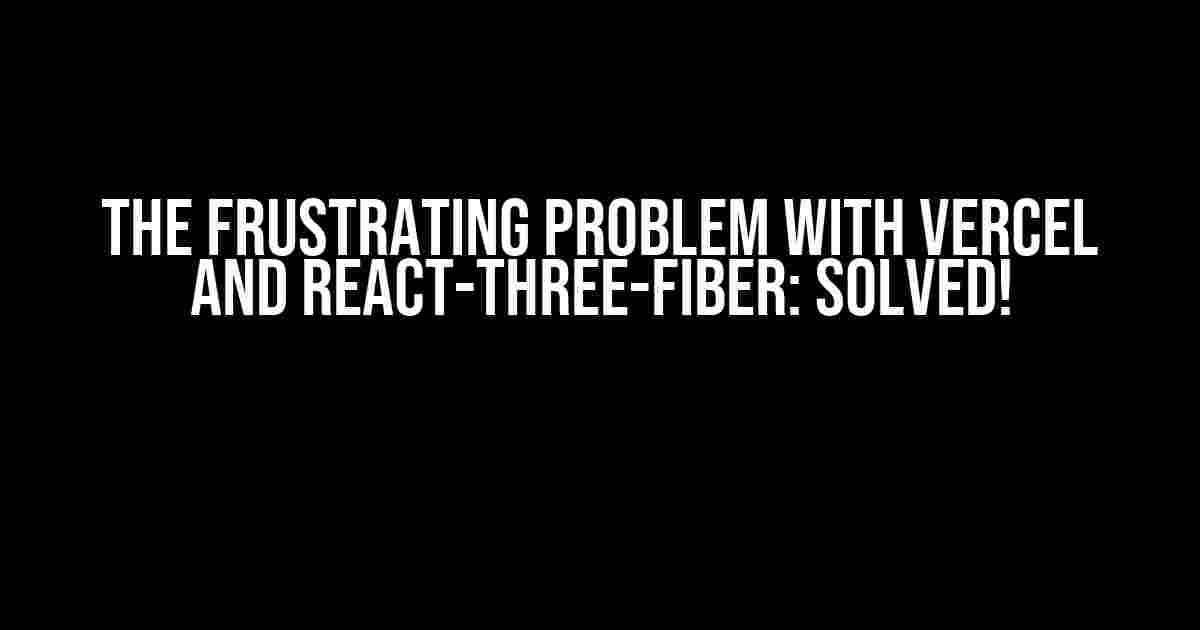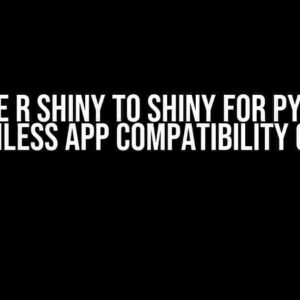Are you tired of struggling with deploying your React-Three-Fiber project on Vercel? Do you keep getting errors and warnings that seem to make no sense? You’re not alone! Many developers have faced this issue, but fear not, for we’ve got the solution right here.
What’s the Problem?
The issue arises when you try to deploy a React-Three-Fiber project on Vercel. Vercel, being a popular platform for hosting and deploying modern web applications, should make it easy to get your project up and running. However, when it comes to React-Three-Fiber, things can get complicated.
The main problem is that React-Three-Fiber uses WebXR, which is not supported by Vercel out of the box. This means that when you try to deploy your project, Vercel won’t be able to render it correctly, resulting in errors and warnings.
Why Does This Happen?
There are a few reasons why this issue occurs:
- WebXR is a relatively new technology, and many hosting platforms, including Vercel, haven’t caught up yet.
- React-Three-Fiber relies heavily on WebXR, which means that it’s not compatible with Vercel’s default settings.
- Vercel’s build process is optimized for traditional web applications, not WebXR-enabled ones.
Solving the Problem
Now that we’ve identified the problem, let’s get to the solution! To deploy your React-Three-Fiber project on Vercel, you’ll need to make some adjustments to your project’s configuration and Vercel’s settings.
Step 1: Update Your `vercel.json` File
In your project’s root directory, create or update the `vercel.json` file. This file contains configuration settings for Vercel. Add the following code:
{
"version": 2,
"builds": [
{
"src": "src/index.js",
"use": "@vercel/static-build",
"config": {
"unsupportedBrowserFeatures": ["webxr"]
}
}
]
}
This code tells Vercel to use the `@vercel/static-build` plugin and configure it to support WebXR.
Step 2: Add a `webxr.js` File
Create a new file called `webxr.js` in your project’s root directory. This file will contain a simple JavaScript function that enables WebXR support:
export function webxr polyfill() {
if (typeof navigator.xr === 'undefined') {
navigator.xr = {};
}
}
This code creates a simple polyfill for WebXR, which will allow Vercel to render your React-Three-Fiber project correctly.
Step 3: Update Your `index.html` File
In your project’s `public` directory, update the `index.html` file to include the following code:
<!DOCTYPE html>
<html>
<head>
<meta charset="UTF-8" />
<title>My React-Three-Fiber App</title>
</head>
<body>
<div id="root"></div>
<script>
import './webxr';
</script>
<script>
import React from 'react';
import ReactDOM from 'react-dom';
import App from './App';
ReactDOM.render(<React.StrictMode><App /></React.StrictMode>, document.getElementById('root'));
</script>
</body>
</html>
This code includes the `webxr.js` file and enables WebXR support in your React-Three-Fiber application.
Step 4: Update Your `App.js` File
In your `src` directory, update the `App.js` file to include the following code:
import React from 'react';
import { Canvas, useFrame } from '@react-three/fiber';
function App() {
useFrame(() => {
// Your Three.js code here
});
return (
<Canvas>
<ambientLight />
<pointLight position={[10, 10, 10]} />
<mesh ref={(mesh) => {
// Your mesh code here
}} />
</Canvas>
);
}
export default App;
This code sets up a basic Three.js scene using React-Three-Fiber. You can customize this code to fit your specific needs.
Deploying Your Project
Now that you’ve made the necessary changes, it’s time to deploy your React-Three-Fiber project on Vercel!
- Run `vercel build` in your terminal to build your project.
- Run `vercel deploy` to deploy your project to Vercel.
- Wait for the deployment to complete. This may take a few minutes.
- Once the deployment is complete, navigate to your Vercel dashboard and click on your project.
- Click on the “Visit” button to view your deployed project.
Congratulations! You should now see your React-Three-Fiber project running smoothly on Vercel.
Troubleshooting Tips
If you encounter any issues during deployment, here are some troubleshooting tips:
- Check your `vercel.json` file for any syntax errors.
- Make sure you’ve updated your `index.html` file correctly.
- Verify that your `webxr.js` file is in the correct location.
- Check the Vercel documentation for any specific requirements or limitations.
Conclusion
Deploying a React-Three-Fiber project on Vercel can be a challenge, but with the right configuration and tweaks, it’s definitely possible. By following these steps, you should be able to get your project up and running smoothly on Vercel.
Remember to stay patient and persistent, and don’t hesitate to reach out to the Vercel or React-Three-Fiber communities if you need further assistance.
| Problem | Solution |
|---|---|
| Vercel doesn’t support WebXR | Use the `@vercel/static-build` plugin and configure it to support WebXR |
| React-Three-Fiber relies on WebXR | Add a `webxr.js` file to enable WebXR support |
| Vercel’s build process is optimized for traditional web applications | Update the `vercel.json` file to configure the build process for WebXR-enabled applications |
We hope this article has been helpful in resolving the problem with Vercel and React-Three-Fiber. Happy coding!
Frequently Asked Question
Having trouble with Vercel and React-Three-Fiber? Don’t worry, we’ve got you covered! Check out these frequently asked questions to get your project back on track.
Why is my React-Three-Fiber app not rendering on Vercel?
This might be due to the fact that Vercel has a strict content security policy that restricts the use of certain scripts and styles. Try adding the ` dangerouslySetInnerHTML` attribute to your `Canvas` component and setting `frames: 1` to get around this issue.
How do I optimize my React-Three-Fiber app for Vercel?
To optimize your app for Vercel, make sure to use the latest version of React-Three-Fiber, and consider using a smaller build of three.js by importing only the necessary components. You can also use tools like Code splitting and lazy loading to reduce the bundle size and improve performance.
Why is my Three.js animation not working on Vercel?
This could be due to the fact that Vercel has a limit on the number of requests made to the server. Try reducing the number of requests by using a single request for all necessary assets, or consider using a service worker to cache frequently used resources.
How do I handle server-side rendering (SSR) with React-Three-Fiber on Vercel?
To handle SSR with React-Three-Fiber on Vercel, make sure to use the `getStaticProps` method to pre-render your pages, and consider using a library like `rehype` to optimize your HTML output.
What are some common errors I might encounter when deploying my React-Three-Fiber app to Vercel?
Some common errors you might encounter include issues with Code splitting, lazy loading, and asset optimization. Be sure to check the Vercel documentation and React-Three-Fiber GitHub issues for solutions to these common problems.



